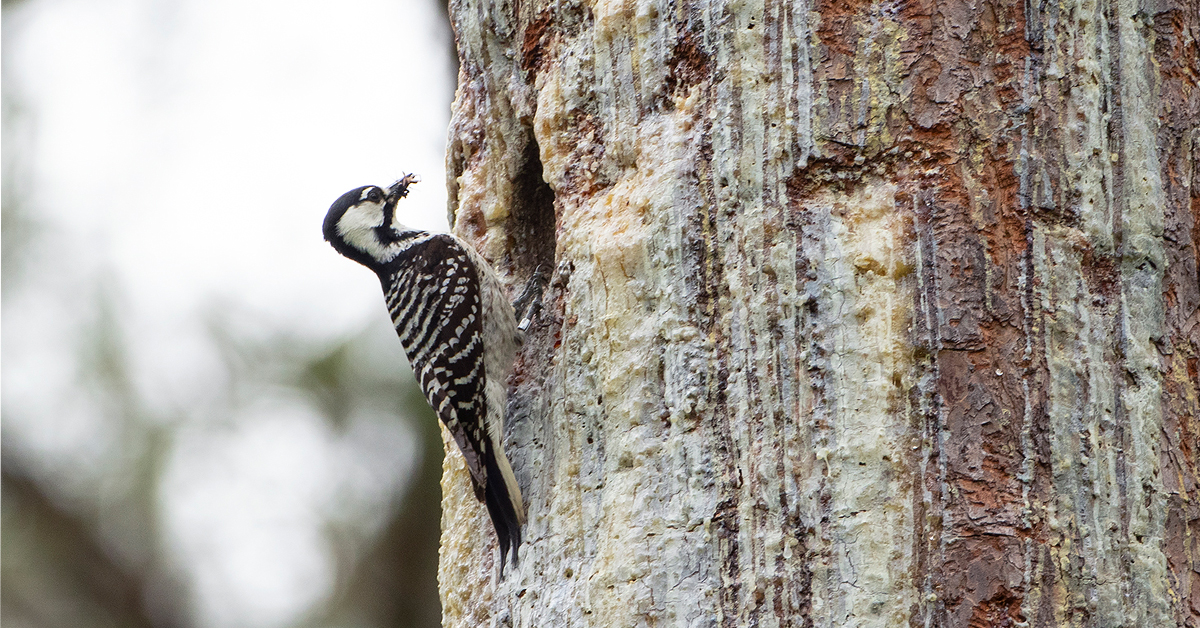
A red-cockaded woodpecker at Big Woods WMA. Photo by Lynda Richardson/DWR
By Molly Kirk/DWR
The tiny, scraggly young bird rested lightly in the wildlife biologist’s palm, oblivious to the excitement running through the group of people peering down at it. The nestling red-cockaded woodpecker, recently hatched in a cavity in a tree on Big Woods Wildlife Management Area (WMA), represented another big step in the recovery of the species in Virginia. The biologist carefully placed color-coded leg bands onto the nestling, then gently replaced it into the cavity high in the longleaf pine’s trunk.

Banding the 2022 red-cockaded woodpecker chicks. Photo by Emma Belling/DWR
Nine months later, Emma Belling trained her spotting scope on a small bird high in the trees. As the Virginia Department of Wildlife Resources (DWR) Wildlife Area Manager at DWR’s Big Woods WMA, one of her tasks is population counts of red-cockaded woodpeckers (RCW). She’d been seeing and hearing an RCW that she suspected was one of the previous year’s fledglings, but she hadn’t confirmed it by identifying the individual by its leg bands. “At first, I could only see it’s right leg, and I could see it was a combination that didn’t match with any of the other birds that I was used to seeing,” she said. “I got a little excited. Then I got a glimpse of its left leg and thought it might be our fledgling. When [DWR Region 1 Lands and Access Manager Matt Kline] and I went out and confirmed it, I was super excited. We were thrilled!”
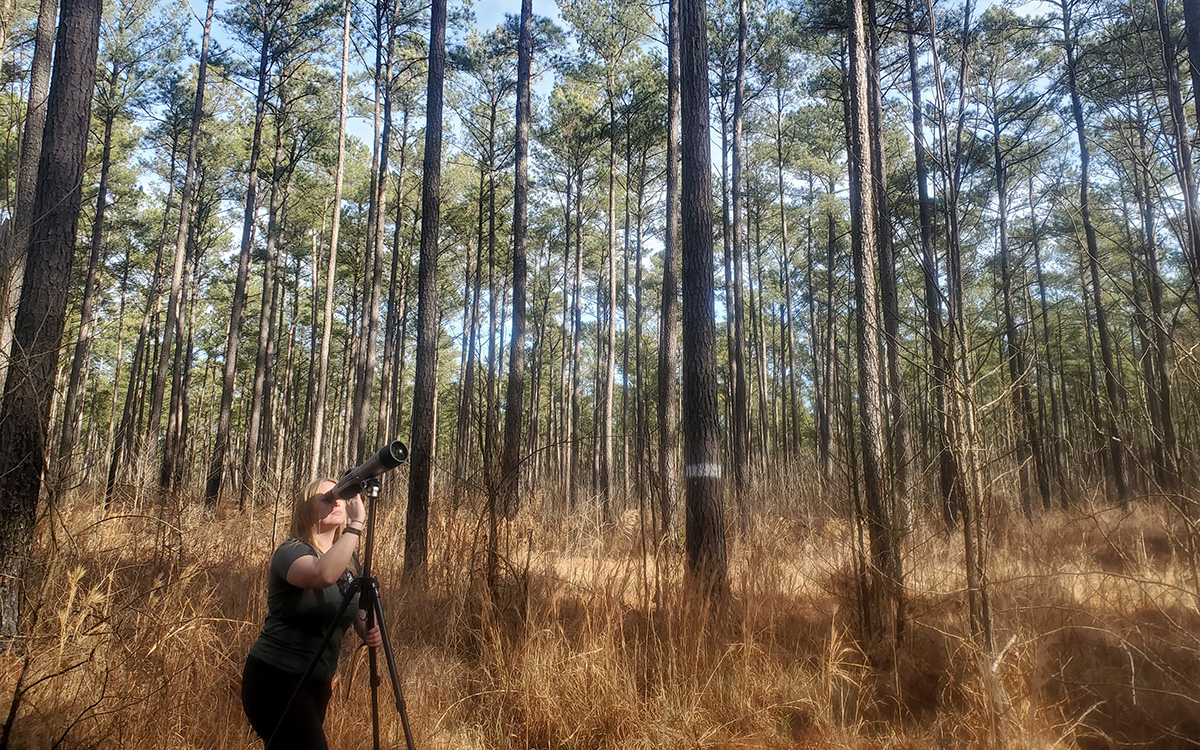
Emma Belling, the wildlife area manager at Big Woods WMA, looking for red-cockaded woodpeckers. Photo by Emma Belling/DWR
Confirming that the red-cockaded woodpecker (RCW) individual they spotted was a maturing fledging from 2022’s clutch of two hatched eggs in Big Woods WMA marked an important milestone for DWR’s efforts to recover the red-cockaded woodpecker (Dryobates borealis). The species has been listed as federally endangered since 1970 and is also state-endangered. Under the Endangered Species Act, the U.S. Fish and Wildlife Service (USFWS) created a National Recovery Plan for RCWs in the 1970s and DWR has a cooperative agreement with the USFWS to serve as the lead agency for the conservation of protected animal species in Virginia, including the red-cockaded woodpecker. Funding sources and regulations made possible by the Endangered Species Act have facilitated DWR’s efforts to recover red-cockaded woodpeckers in Virginia, so it’s fitting that this milestone on the Big Woods WMA coincides with the 50th anniversary of the ESA.
“The discovery of last year’s fledgling during this year’s winter count is incredibly exciting news, as it is the first known successful fledging at Big Woods WMA in three years,” said DWR Nongame Bird Conservation Biologist Sergio Harding. “The bird was missed during checks for fledglings in 2022 because it unexpectedly took shelter in a different cavity than the one where it was hatched. With ongoing habitat management on the WMA, we look forward to continuing to grow the red-cockaded woodpecker population while also benefiting a large variety of both game and nongame species.”
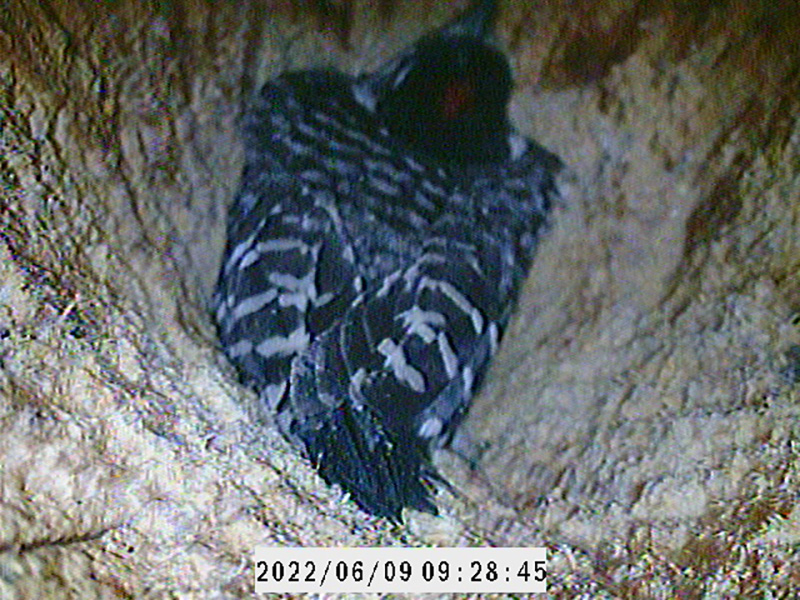
The fledgling was spotted in a nesting cavity by a “peep camera,” but wasn’t able to be positively identified because its leg bands weren’t visible. Photo by Emma Belling/DWR
The RCW is a unique species of woodpecker that depends on very specific habitat for nesting. They depend on old-growth southern pine forests for food and habitat, since they excavate nesting cavities in living pine trees. They choose pine savannas—pine forests with open understory—for building those nests, and pine savannas depend on regular fire events and forest management to maintain the open understory. Their preferred habitats have shrunk dramatically in the past two centuries thanks to clearcutting, forest fragmentation, and fire suppression.
RCWs are also unique in that they are cooperative breeders (only three percent of all bird species breed in this manner). They live in family groups whose offspring from previous years delay their own reproduction in order to help parents raise their future siblings. The dynamics of this breeding system limit the number of birds that are nesting in any given year. This behavior, in conjunction with the mechanics of excavating cavities in living trees and the dependence on mature and open forest conditions, contributes to long recovery times for the RCW population as a whole. Restoration of this unique species requires patience and a long-term view, but thanks to regulatory actions and funding made possible by the ESA and with continued collaboration among partners like The Nature Conservancy (TNC) and The Center for Conservation Biology at the College of William and Mary (CCB), DWR has made significant strides in RCW recovery.
In 2009, DWR was able to purchase the Big Woods WMA, which lies next to the Piney Grove Nature Preserve, owned by The Nature Conservancy (TNC), where an existing population of RCWs was in need of expanded habitat. Funds for the purchase of Big Woods came through a recovery land acquisition grant through the ESA, a program that assists with purchases of land for the protection of federally listed species. With the addition of a grant from The Virginia Land Conservation Foundation and some bonds, DWR was able to complete the purchase of 2,204 acres in a way that was a new approach for the agency.
DWR and partners have implemented intensive habitat management work at Big Woods, including forest thinning and prescribed burns of hundreds of acres to open up the understory. In 2016 the first calls of an RCW were heard at Big Woods. “The timber harvest of 427 acres, which thinned the timber in stands around the cluster in 2018 and ‘19, the Restore the Wild herbicide project in the fall of 2020 to eliminate undesired hardwoods and open that habitat up, and the consistent prescribed burns with our partners have all helped us get to where we are with the RCWs on Big Woods now. There was also a lot of hard, dedicated detective work by field staff monitoring these birds,” said Stephen Living, DWR’s habitat education coordinator.
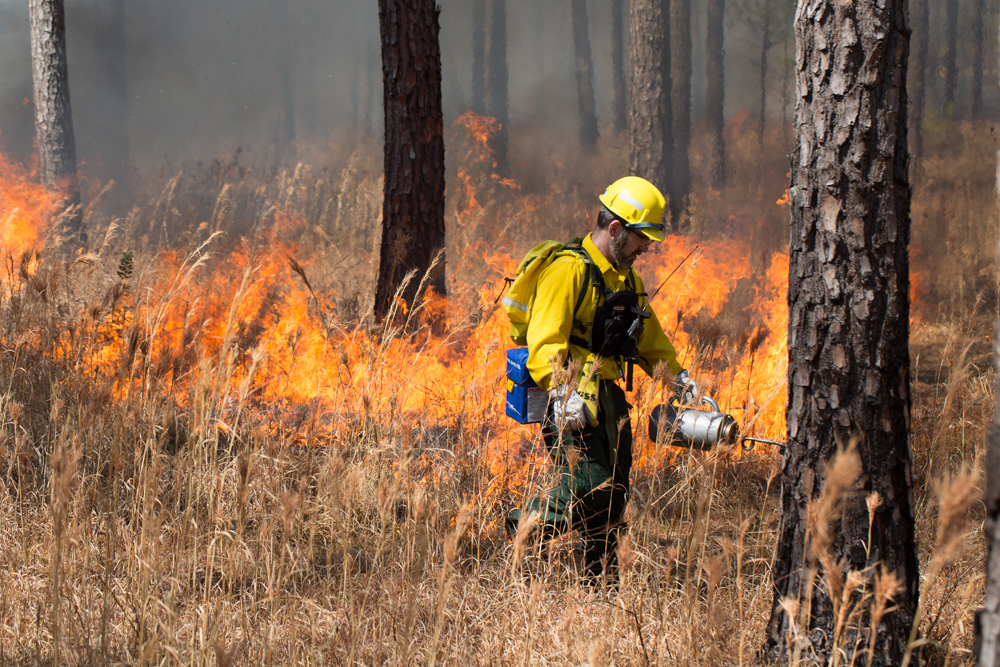
Prescribed fire is an effective tool for creating the habitat needed for red-cockaded woodpeckers. Photo by Matt Kline/DWR
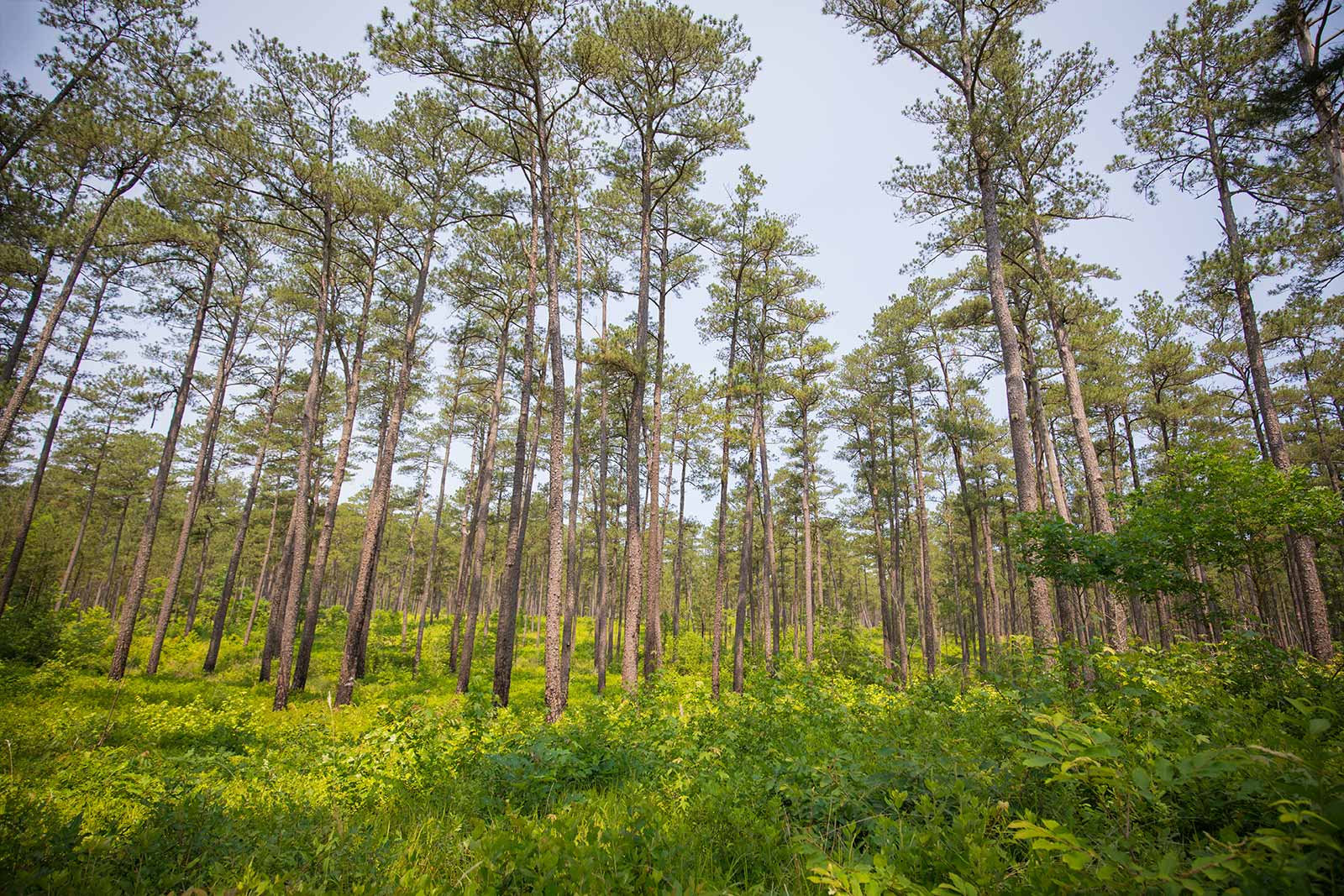
Pine savanna habitat at Big Woods WMA. Photo by Meghan Marchetti/DWR
While much of this habitat work is aimed at creating optimal conditions for the RCW, it’s also extremely beneficial for more common wildlife species on the property, including game species. “I think it’s our best example of managing for the most common game species, like deer, turkey, and quail, in addition to the most imperiled species, like the red-cockaded woodpecker,” said Gwynn.
From 2002 to 2022, the RCW populations at Piney Grove and Big Woods WMA grew steadily—from 6 birds found on Piney Grove in 2002 to 85 adults counted at Piney Grove and Big Woods combined in 2023.
In 2017, DWR and TNC biologists discovered a banded male red-cockaded woodpecker with an active cavity on Big Woods WMA. The bird had originated from the Piney Grove population. Although the species historically occurred in Sussex County, this was the first documented occurrence of an individual or cavity on the WMA, demonstrating that the DWR’s restoration efforts were making a difference and Piney Grove’s woodpeckers were finding the expanded habitat they need, even ahead of the timeline DWR biologists expected. By January 2023, it’s estimated that between five and seven RCWs are using the Big Woods habitat.
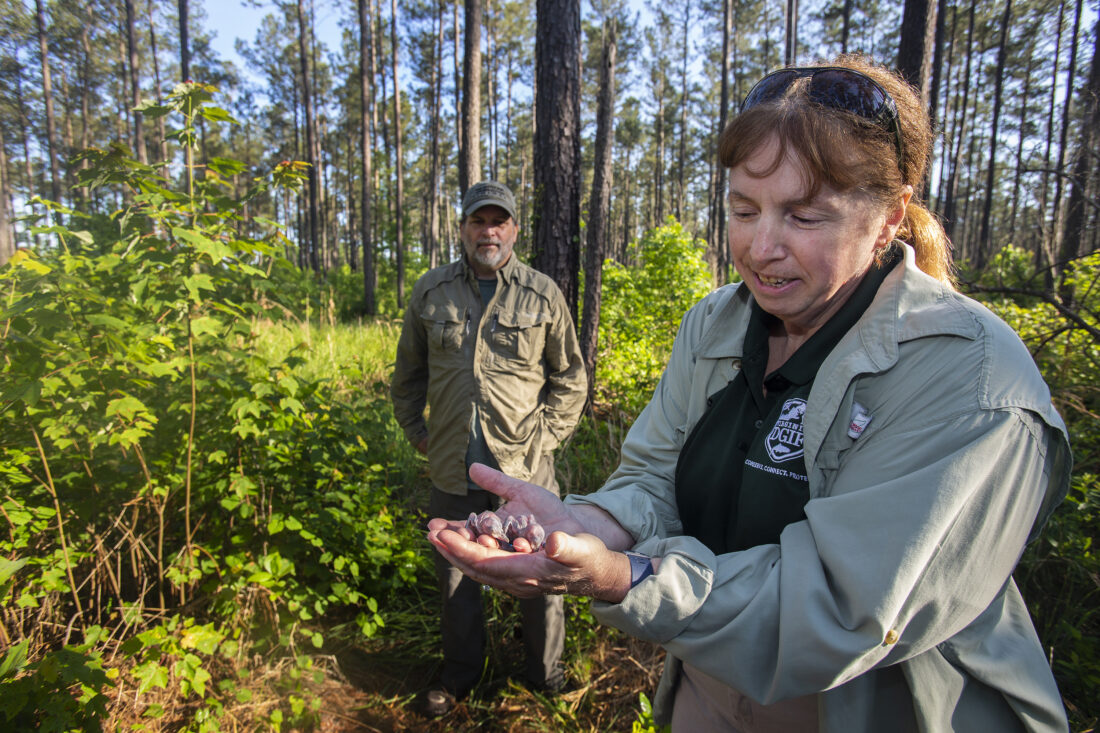
DWR Deputy Director Becky Gwynn holding two red-cockaded woodpecker nestlings with Bryan Watts, director of The Center for Conservation Biology, William & Mary in the background. Photo by Lynda Richardson/DWR
In 2019, the first two RCW nestlings hatched in a cavity on the Big Woods WMA, followed by two more in 2020, 2021, and 2022. Unfortunately, population monitoring had not located any surviving nestlings until Belling recently spotted the chick hatched and banded in 2022. “When we’ve had fledglings that we weren’t able to confirm their survival or whereabouts, we really didn’t know what the missing component was—whether it was habitat or predators or bird behavior,” said Kline. When Kline and Belling were looking for the 2022 fledglings months after they fledged, they saw evidence that one had been lost to predation. “We couldn’t find the other one, so we assumed it was also lost to predation. It was very exciting that Emma found this one and we were able to confirm it. It still doesn’t answer all our questions, but we know that the habitat is sufficient to raise a fledgling to maturity.”
DWR and partners are optimistic that long-term efforts, including continuing habitat management and expansion, will eventually help create a more robust and resilient population of red-cockaded woodpeckers. The best way to join the effort to restore the red-cockaded woodpecker is to become a Restore the Wild member or donate to Restore the Wild. The Restore the Wild initiative supports DWR habitat projects vital to the survival of Virginia’s wildlife.


